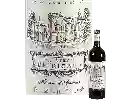Top 100 red wines of Entre-deux-Mers
Discover the top 100 best red wines of Entre-deux-Mers of Entre-deux-Mers as well as the best winemakers in the region. Explore the varietals of the red wines that are popular of Entre-deux-Mers and the best vintages to taste in this region.



































































































